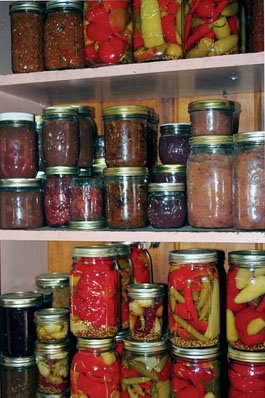home | metro santa cruz index | santa cruz county restaurants | review

Yes, We Can! : Apple butter, stewed tomatoes and pickled peppers--autumn is the time for self-proclaimed locavores to put up or shut up.
Notes from the Stash Master
It's easy to eat local in Santa Cruz during the summer. But winter's coming, and it's time to put up.
By Ari LeVaux
In summertime, eating local is easy. Restaurants are going local on their specials boards, friends are doing it at pot-lucks and farmers markets have become so schmoozey that some folks just show up for the party and eat something local because it's there.The increasing hipness of local food is encouraging. But there's a difference between socialites, passive consumers and other lightweights who dabble their toes when the water's warm and those to whom eating local is a lifestyle choice, not a menu choice. The distinction between locavores and trendivores lies in what they eat during winter.
While the prospect of eating local in the off-season may seem daunting, it can be as simple as buying a sack of potatoes at the farmers market to store in your garage. Maybe next year you'll dig a root cellar. Meanwhile, there are two simple baby steps you can take toward turning your home into a domestic food storage unit: Acquire a stash, and stash it.
How and what you stash depends on local conditions and your resources. It requires the flexibility to roll with the tides of availability, and boils down to developing a stash-hunting frame of mind that's ready to go at a moment's notice. I've got a neighbor who catches more fish than he can eat, and I've trained him to bring fish home. But when he does, I have to drop what I'm doing and dive arm-deep into fish guts. Such moments are the stash hunter's burden and joy.
When it comes to stash hunting, farmer friends are key--or at least farmer acquaintances, which can be upgraded. Perhaps the folks you've been buying basil from all summer at farmers market are candidates. At a certain point, those basil plants will begin to flower so vigorously that most farmers will stop harvesting them, as the stalks no longer bunch nicely. You, meanwhile, want pesto all winter, and offer to come over and clean out the basil patch for a good price. If it's a go, this adventure may lead to other opportunities. Perhaps you can glean the side shoots of their cauliflower or broccoli plants, which usually get left behind after the main heads are harvested. The side shoots are smaller, but store fabulously frozen (after getting blanched for two minutes in boiling water, plunged into an ice bath, drained and bagged).
I don't make pesto, exactly, I make pistou, a simpler version that leaves more options on the table for when I use it (I can add Parmesan cheese and pine nuts later, if pesto is what I want). For pistou, start with chopped garlic and olive oil in the food processor. With the blades going, add basil leaves as quickly as possible. It will thicken into a liquid paste that pulls itself through the blades in a smooth green vortex. Don't skimp on oil or it will turn brown; you can also give a squirt of lime for extra bright green. Before it thickens to the point where it won't pull smoothly through the blades, whizz in salt to taste, and freeze your pistou in quart bags.
Toward the end of market is when the best deals are, and the hard-cores have their favorite methods for preserving whatever remains unsold, and is thus on sale. Score a deal on tomatoes? Go for salsa, or oven-roasted tomato sauce. Got peppers? The small, fleshy ones are great pickled, alone or in combination with cauliflower and/or carrots.
For most pickles, I use a brine that's half water, a quarter cider vinegar and a quarter white wine vinegar. As the brine heats, add enough sugar to take the edge off the vinegar, but not enough to sweeten it. To each empty jar add a tablespoon of mustard seeds and a teaspoon of salt. Pack the jars with veggies, pour in the simmering brine, and either hot pack or process in a water-bath. (Note: If you're new at pickling, you should consult a reference like www.howtopickle.com for step-by-step instructions.)
In addition to chutneys, sauces, jams and pickles, a balanced stash includes minimally processed components as well, either frozen or in simple cold storage. Carrots, onions, garlic, potatoes, beets, winter squash and many other veggies can last for months with the temperature somewhere between cold and freezing. So before you dig a root cellar, investigate your house for possible stash-spots like crawl-spaces, unheated basement spots or the garage. Even if the local portion of your winter diet consists only of a sack of potatoes from the farmers market stashed in a corner of your garage, it's good to stash something. And after a winter spent wishing you'd stashed more, next summer you probably will.
Send a letter to the editor about this story.
|
|
|
|
|
|